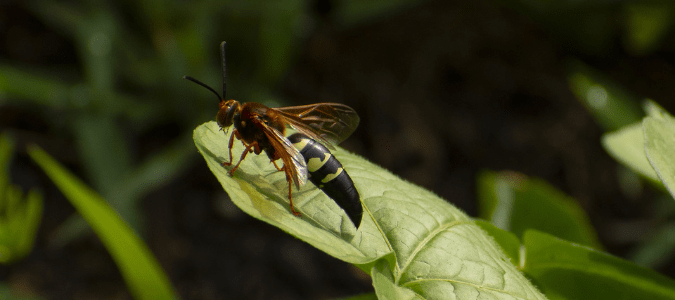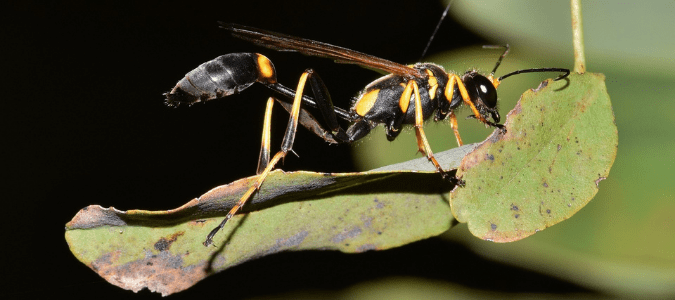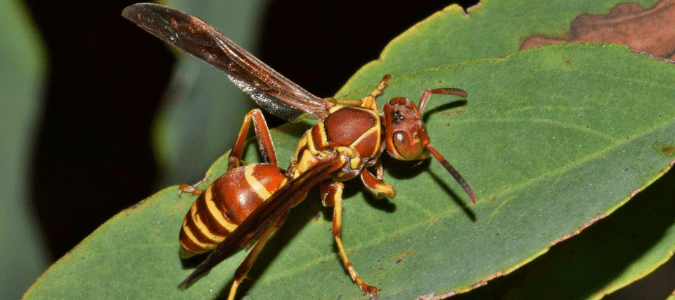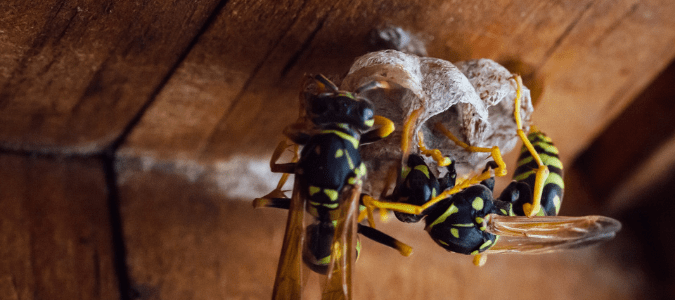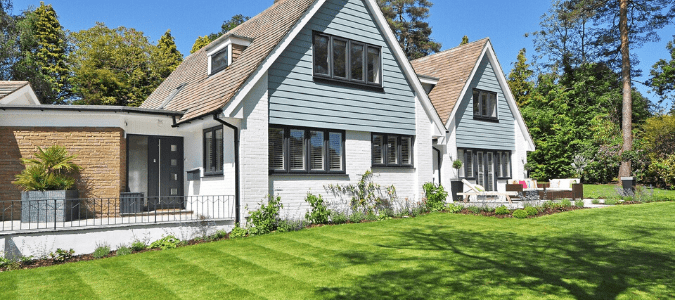If you have noticed some six-legged creatures flying around your property, you are probably wondering what kind of insects you are dealing with. Since some insects look alike, it can be difficult for homeowners to figure out what kind of bug is well, bugging them. Wasps are one of the most common flying insects that homeowners encounter, but not all wasps will hurt you. Although some of these creatures are dangerous to humans, some other types might even be beneficial and help get rid of other pests.
Some of the kinds of wasps that you might find on your property include cicada killer wasps, mud dauber wasps, paper wasps and yellowjackets.
Cicada Killer Wasps
As you can see in the image above, the cicada killer wasp is about an inch and a half long, and it’s mostly black with orange wings and some yellow markings on its abdomen. They can look scary because they are some of the larger types of wasps and some have big stingers. However, cicada killer wasps are not usually aggressive towards humans. In fact, only the females actually have stingers. Male cicada killer wasps might hover around if you invade what they think is their territory. But, they don’t have stingers to attack you with.
Cicada killer wasps are not social, which means that each female wasp typically builds its own nest. However, they might build their nests in the same area as other cicada killers. The nests are a hole the wasp digs into the ground, which can be up to 70 inches long and can include multiple side chambers. The female wasp puts an egg in each chamber along with one or more cicadas after they’ve paralyzed them with their stinger.
Much like digger wasps, cicada killer wasps are most likely to build their nests in dry soil in sunny areas like gardens, flower beds and lawns near trees with cicadas. They also sometimes dig nests in the sand on golf courses or playgrounds. If you see a hole in your yard that’s surrounded by large piles of loose soil, then you might have a cicada killer wasp nest.
Mud Dauber Wasps
Mud daubers are black wasps that are long and thin—typically around a half-inch to inch long. They also sometimes have yellow markings at the waist. They are not typically aggressive towards humans and don’t usually sting.
Mud daubers are solitary wasps, which means that each wasp typically builds its own nest—also called a brood chamber. They use mud to build nests under the eaves and on the sides of buildings. The nests usually consist of several tubes side-by-side. Depending on the type of mud dauber, each tube might be about an inch long or as long as ten inches apiece. The wasps lay eggs in these nests and they place paralyzed spiders with each egg. Once the wasp larva hatches, it feeds on the spider until it grows big enough to leave the nest. Then, it will break a hole in the side of the chamber and take off.
Paper Wasps
Paper wasps come in a variety of colors. Some are yellow with brown spots, while others are dark brown or black with yellow or red spots. And, some paper wasps are orange or red. They are social wasps, which means that if you see one paper wasp, then there are likely many more around. This is because they usually nest together in groups.
These wasps can be aggressive towards people if you disturb the wasps or their nests. But, they aren’t as aggressive as some other types of wasps. The biggest risk is if they build a nest near a door, window or some other area that you or your family might accidentally disturb while going about your daily activities.
Paper wasps get their name because they build nests that look like they’re made of paper. These nests also have a shape like an upside-down umbrella. Paper wasp nests, which can hold up to 250 wasps, are usually found in protected areas, such as in shrubs or under the eaves of buildings. The wasps lay eggs in the nests and then bring food, such as small insects and caterpillars, to feed the larvae.
Yellowjackets
Yellowjackets are one of the most dangerous kinds of wasps because they can be very aggressive towards humans. This holds especially true if you disturb their nests or disturb the wasp itself by trying to swat it away. Even more frightening is that the same wasp can sting a person multiple times. Additionally, yellowjacket nests can hold tens of thousands of wasps. This means that if you disturb a nest, then you might get stung by thousands of insects.
It can be easy to accidentally disturb a yellowjacket nest because these wasps often build their nests in the ground in burrows left by other animals in areas like gardens. Other types of yellowjackets sometimes build nests in the cavities of trees, gaps in walls or ceilings, off of tree branches or under the eaves of buildings like porches and home garages.
Like paper wasps, yellowjackets typically build paper-like nests out of materials like wood fibers. But, these nests are usually bigger than paper wasp nests. Additionally, unlike paper wasp nests, yellowjacket nests are typically completely enclosed and have only one hole, which the wasps use to enter and exit the nest.
One way to identify yellowjackets is by looking at their coloring, as they are usually black with yellow or white stripe-like spots on their abdomen. You might also be able to identify what kind of wasp you have based on where you see it. Yellowjackets, which are about half an inch long, might be the pests that are swarming around your picnic. These wasps are attracted to food around garbage cans, bowls of pet food, gardens with fruit and outdoor picnics.
Since many types of wasps are dangerous to humans and pets, the safest and easiest thing to do is to contact a pest control specialist as soon as you notice an uptick of wasp activity on your property or if you find a bee or wasp nest. These professionals have the training and experience to figure out what kind of wasp is on your property. Additionally, they have tools at their disposal to control these pests, so you don’t have to worry so much about stinging pests.
How to Get Rid of Cicada Killer Wasps
Cicada killer wasps are rather big bugs, which can be scary for most people. Plus, they can look very similar to some other kinds of dangerous insects. Thankfully, they are typically not harmful to humans. However, these wasps can damage your patio or your lawn, plants, vegetables and other landscaping when they dig a hole for their nest.
If you spot a nest, one way to deter cicada killer wasps is to pour a lot of water around the nest. These wasps don’t like wet soil, so this might encourage them to leave. However, they might return after the soil dries. Not to mention, putting too much water on your plants could damage them.
If you hire a pest control specialist, there are several other methods that they can use to control cicada killer wasps. For example, they can use a targeted application of insecticide on the entrance of the cicada killer wasp nest or inside the nest. Using this targeted method is one way to reduce the possibility of side effects from the insecticide on your yard. Also, it’s usually a more effective way to control these kinds of wasps rather than spraying a large area.
The best way to deal with wasps is to contact a pest control professional. They can work with you to design a pest control plan that best fits you and your family’s needs and goals for your property.
What Do Paper Wasps Eat?
Paper wasps usually feed on nectar and sugary juices. They will also happily feed on caterpillars, small insects and other pests, including:
- flies,
- beetle larvae,
- corn earworms,
- spiders,
- loopers,
- cabbage butterflies,
- armyworms
- fall webworms and
- hornworms.
These wasps can be a form of natural pest control because they eat many kinds of pests that can destroy plants. However, many homeowners prefer not to have these paper wasps buzzing around. This is because they can attack and sting humans and pets, especially if they think you’re threatening their nest.
Paper wasps can be a major problem when you’re trying to trim your shrubs or pick fruit from your garden because they often build nests in these areas. Additionally, if you try to remove a wasp nest on your own, then they might attack you in response to this threat to their home. That’s why it is usually best to contact a professional to help reduce wasp populations around your home and yard. They can help keep your family safe by taking care of everything needed to get rid of the pests on your property.
ABC Can Handle the Wasps on Your Property for You
You shouldn’t be in fear every time you step outside. Instead of letting wasps overrun your yard, contact ABC Home & Commercial Services. Our pros will assess the situation and create an effective pest treatment plan. This way, you and your family members can enjoy time in your home and yard without worry about painful stings.
